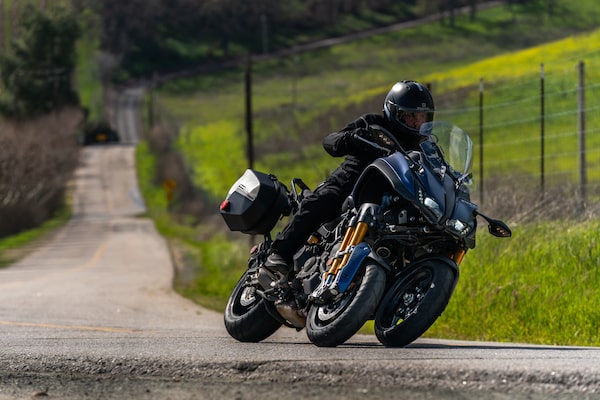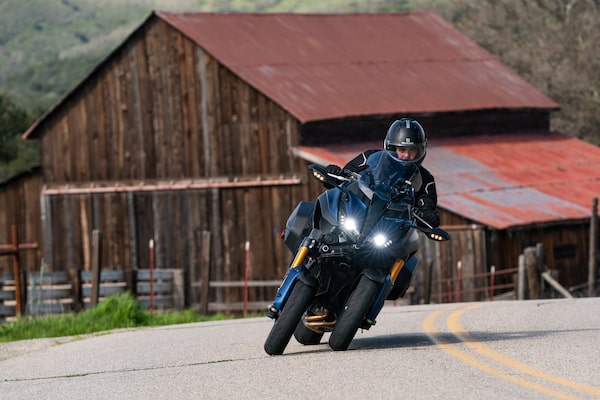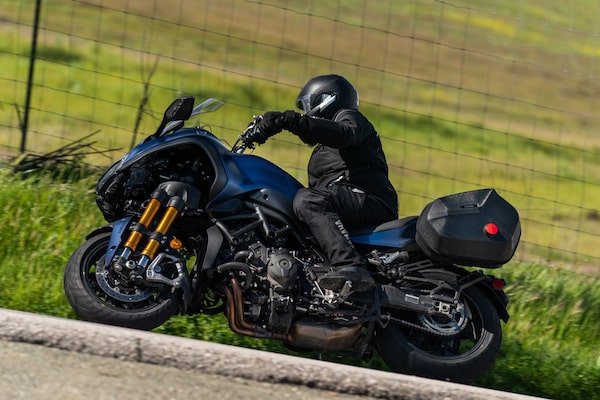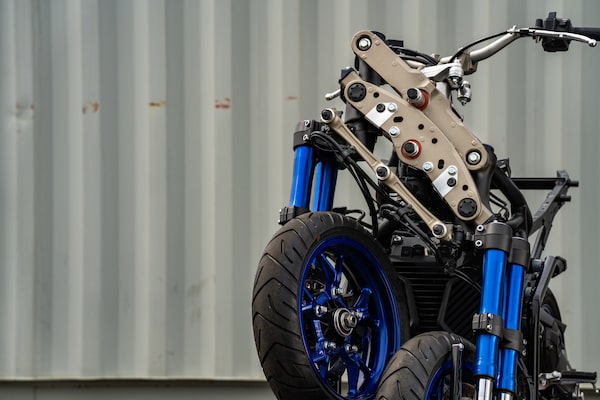
The three-wheeled Yamaha Niken.
Does the world need a three-wheeled motorcycle? Yamaha thinks it does, which is why we now have the $21,000 Yamaha Niken.
This is not a trike, like those big Harley-Davidsons or Honda Gold Wings that have two wheels at the back and one in front. Those don’t lean around corners, and they’re intended to be stable, well-planted machines for, often, older riders.
Nor is this a Can-Am machine, with two front wheels wide apart and a single rear wheel, which also does not lean around corners. Can-Ams are sportier and ride like snowmobiles on wheels. They’re also favoured by older riders for their stability.
No – the Niken is a true motorcycle that will fall over if you don’t put your feet down at a stop. When you ride it, it feels like a motorcycle, mostly because those two front wheels and their 15-inch tires are hidden from sight to the rider by what seems to be an extra-large gas tank. And when you go around a corner, it leans and leans and leans, all the way until the pegs touch the ground.
So what’s the point? According to Yamaha, it’s because those two front wheels “reduce the effects of changes in the ride environment and inspire front-end confidence when turning.” Which means that the bike will provide more grip on a road that’s slippery from rain or sand.
A weekend-long (don’t) crash course in riding a motorcycle
I love convertibles but need four doors for my grandkids. Do I have any options?

Yamaha says the extra front wheel provides extra grip, particularly on wet or rough terrain.
On a motorcycle, a rear-wheel skid is no big deal, but a front-wheel skid is almost impossible to control. A friend had already ridden the Niken in wet weather and vouched for its extra grip while turning and braking, but the roads stayed dry during my time with the bike. Instead, I went looking for gravel roads and sandy roads – something I would never do on a motorcycle with street tires.
If we forget about those front wheels for a moment, the Niken is very similar to a Yamaha Tracer 900. It has the same 847cc inline-triple engine, with slightly different mapping for its 113 hp and a stronger crankshaft, and a wheelbase that’s only 10 mm longer. It weighs about 40 kilograms more.
The steering geometry is very clever, and similar to the new Honda Gold Wing. The handlebar is connected to the front wheels through linkages, which helps to isolate it from bumps and also lighten the steering input. You don’t really notice that it’s not a direct connection, however.
In fact, you do get used to the bike riding exactly like a motorcycle. You never quite forget because the 18-litre gas tank and its plastic shrouding is very wide, but the handlebars and bags are still wider than the two front wheels, so there are no surprises. Because those wheels are less than 460 mm apart, the Canadian government is comfortable classifying the Niken as a motorcycle – unlike the grey area of Can-Ams and Slingshots and the like.
Because the front wheels aren't wider than the handlebars or bags, the Niken is still classified as a motorcycle.Mark Richardson/The Globe and Mail
I found a long stretch of gravel road and set off on the loose stones. Normally on a motorcycle, it’s important on gravel to sit back on the seat to relieve the weight of the front wheel, because it’s very easy to dig into a rut that can catch and throw you off. It can be disconcerting, and I have friends who refuse to ride on gravel. I had no such concern with the Niken. I still rode with caution and respect for the jittery surface, and traction control set to the maximum, but the bike went where it was pointed with little muss or fuss.
On another stretch of little-travelled paved road, liberally scattered with fine sand on every sliding curve and tight corner, I rode slowly and carefully from one end to the other, then returned more quickly. Where a motorcycle would normally slip on the sand before eventually (hopefully) catching its grip, the Niken squirmed just a touch as one tire slipped but the other held. This was not an unpleasant feeling – in fact, it was kind of fun and even a little addictive.
I rode back and forth, back and forth, faster and faster as my confidence grew. I never did travel as fast as I might in a slewing car, but I went considerably more quickly than I would on a regular motorcycle. Of course, it’s not just about riding faster until you find the limit – it’s also about riding more safely at well below the limit, and for that, the Niken could not be faulted.

Befitting a true motorcycle, the Niken can lean deep into turns.
In the United States, there are two possible versions of the Niken available in Yamaha showrooms: the base-level Niken and the better-equipped Niken GT, which costs US$1,300 more. Here in Canada, we only get the Niken GT, with the additional semi-soft saddlebags, heated grips, cruise control and a taller windscreen.
However, its $20,999 price tag seems high for a bike with easily scratched paint on the tank and a monochromatic digital gauge display. It seems especially high compared with a $14,599 Tracer 900 GT, and is almost twice the price of a basic Tracer 900. Is the extra wheel and multilink steering really worth more than $6,000 on its own?
Probably not, but the Niken is still a bold new experiment for Yamaha. And if you ever do hurl your motorcycle into a slippery corner and the front end slides out, I can bet you’ll wish then you had that extra wheel to keep everything under control.

The handlebars are connected to the front wheels through linkages, which helps to isolate it from bumps.
Tech specs
- Base price/As tested: $20,999
- Engine: 847 cc liquid-cooled inline triple
- Transmission/Drive: Six-speed / Chain
- Alternatives: Yamaha Tracer GT
Shopping for a new car? Check out the new Globe Drive Build and Price Tool to see the latest discounts, rebates and rates on new cars, trucks and SUVs. Click here to get your price.
Stay on top of all our Drive stories. We have a Drive newsletter covering car reviews, innovative new cars and the ups and downs of everyday driving. Sign up for the weekly Drive newsletter, delivered to your inbox for free. Follow us on Instagram, @globedrive.